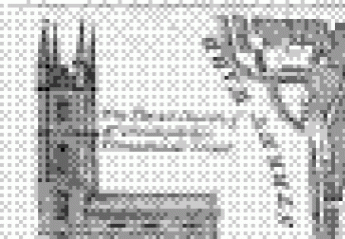The following text is from a project completed by the former Clerk of the House of Commons, Sir David Natzler. He was engaged to identify tripoints, the points within the City of London at which any three of the City’s wards intersect. Here are his paragraphs about Broad Street Ward:
“24. Bishopsgate/Broad Street/Cornhill: where Wormwood Street running west along the line of the wall becomes London Wall, crossing Old Broad Street. On the south side Deutsche Bank occupies the 10 storey French limestone- faced No 75 London Wall, once known as Winchester House: the bankers can relax at the Be At One cocktail bar opposite. On the north east beyond No 55 are the churchyard and garden and netball court of St Botolph without Bishopsgate, the church where Keats was baptised and the Bishopsgate ward church; and a truly remarkable Victorian Turkish-style bath house. On the north west is the neglected brickwork of All Hallows Church on the Wall, a plain Classical building of 1767 completed by George Dance. It has long been a source of good works. The 19th century hymnodist Samuel John Stone ended his career as rector here: earlier he had written Lyra Fidelium, including the “Church’s One Foundation”. Another remarkable rector was Montague Fowler, who made All Hallows a refuge for the poorly paid city workers who came in early to benefit from the cheap fares. It is now run as a community church by the evangelical network City Gates. It is a reminder of the strong tradition of social service from some City churches, even when they are neither beautiful nor readily accessible to visitors.
“25. Bishopsgate/Broad Street/ Coleman: the point where Liverpool Street comes past the railway terminus for East Anglia and boats for the Low Countries to meet Blomfield Street, opposite Broad Street Place at 31-37. Here is now the giant portal for the Elizabeth Line station. The old buildings at 1-14 Liverpool Street have been demolished to be replaced by a new office building One Liverpool Street developed by Aviva and TfL. On Broad Street Place is a plaque to St Mary Moorfields, a church built in 1820 and serving as the pro-Cathedral of the Roman Catholic church from 1850 to 1870. It was demolished in the 1890s. Blomfield Street is the line of the Walbrook stream dividing the City: the Walbrook skulls from Roman or Celtic times were found here in the waterway. To the west of Blomfield Street is the amazing Finsbury Circus, now alas without its bowling green but still the largest open space in the City, and a rare example of restraint in the intensive development of the city in the 19th century.
“26. Broad/Cornhill/Walbrook: the tripoint is where Throgmorton Street, with some well- preserved Victorian buildings, one numbered in its stonework XXVI which the Post Office would not like, enters Old Broad Street. Behind the buildings in the north west angle along Austin Friars Lane is the church of Austin Friars, rebuilt after the war, and originally the centre of the Augustinian Friars settlement, founded in the 13th century. It has been used since the Reformation by foreign Protestants and is still the Dutch Church, the oldest Dutch language church in the world. On the Old Broad Street front was the church of St Peters le Poer, just outside the monastic precinct, demolished in 1907 and transferred to Friern Barnet. Drapers Hall on the north side of Throgmorton Street occupies the site of a mansion on former Augustinian land once occupied by Thomas Cromwell; the London Stock Exchange was opposite Drapers Hall in 125 Old Broad Street in the Stock Exchange Tower until it moved out in 2004. Adam’s Court on the east side, which runs through to Threadneedle Street, is named after a Draper Lord Mayor from the troubled times of 1645. Here too is a splendid tripoint marker, a non-functioning light blue City police telephone, in a slightly better state than the modern black-painted New World telephone box down the Road past the City of London Club at No 19.
“27. Broad/Coleman Street/Walbrook: this is an oddity as the boundary line dividing Broad Street and Coleman Street wards runs – and has long run – northwards straight through the middle of the church of St Margaret Lothbury; there are ward badges on the church and each ward has its noticeboard here. All that is missing is a neat boundary line up the brickwork. The tower is in Coleman Street ward. The boundary is the Walbrook which ran and presumably still runs in a culvert underneath the church. Stow in his 1598 account of London divided the wards into those east and west of the Walbrook, reflecting a division that goes back many centuries: Ludgate Hill against Cornhill. St Margaret Lothbury is an archetype of a well-loved City church, with fitments from St Christopher le Stocks nearby, which was removed to create the modern Bank of England building, sword rests loaded with livery badges, and so on. To its east at 7 Lothbury is a splendid City Venetian Gothic mini-palace built in 1866, now converted into private flats. To the south is where the gold used to enter the Bank of England, and presumably leave it.”

